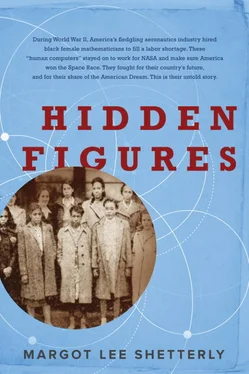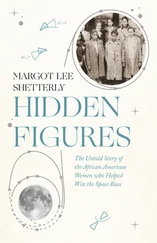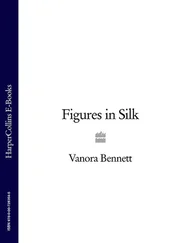The spark of curiosity soon became an all-consuming fire. I peppered my father with questions about his early days at Langley during the mid-1960s, questions I’d never asked before. The following Sunday I interviewed Mrs. Land about the early days of Langley’s computing pool, when part of her job responsibility was knowing which bathroom was marked for “colored” employees. And less than a week later I was sitting on the couch in Katherine Johnson’s living room, under a framed American flag that had been to the Moon, listening to a ninety-three-year-old with a memory sharper than mine recall segregated buses, years of teaching and raising a family, and working out the trajectory for John Glenn’s spaceflight. I listened to Christine Darden’s stories of long years spent as a data analyst, waiting for the chance to prove herself as an engineer.
Even as a professional in an integrated world, I had been the only black woman in enough drawing rooms and boardrooms to have an inkling of the chutzpah it took for an African American woman in a segregated southern workplace to tell her bosses she was sure her calculations would put a man on the Moon. These women’s paths set the stage for mine; immersing myself in their stories helped me understand my own.
Even if the tale had begun and ended with the first five black women who went to work at Langley’s segregated west side in May 1943—the women later known as the “West Computers”—I still would have committed myself to recording the facts and circumstances of their lives. Just as islands—isolated places with unique, rich biodiversity—have relevance for the ecosystems everywhere, so does studying seemingly isolated or overlooked people and events from the past turn up unexpected connections and insights to modern life. The idea that black women had been recruited to work as mathematicians at the NASA installation in the South during the days of segregation defies our expectations and challenges much of what we think we know about American history. It’s a great story, and that alone makes it worth telling.
In the early stages of researching this book, I shared details of what I had found with experts on the history of the space agency. To a person they encouraged what they viewed as a valuable addition to the body of knowledge, though some questioned the magnitude of the story.
“How many women are we talking about? Five or six?”
I had known more than that number just growing up in Hampton, but even I was surprised at how the numbers kept adding up. These women showed up in photos and phone books, in sources both expected and unusual. A mention of a Langley job in an engagement announcement in the Norfolk Journal and Guide . A handful of names from the daughter of one of the first West Computers. A 1951 memo from the Langley personnel officer reporting on the numbers and status of its black employees, which unexpectedly made reference to one black woman who was a “GS-9 Research Scientist.” I discovered one 1945 personnel document describing a beehive of mathematical activity in an office in a new building on Langley’s west side, staffed by twenty-five black women coaxing numbers out of calculators on a twenty-four-hour schedule, overseen by three black shift supervisors who reported to two white head computers. Even as I write the final words of this book, I’m still doing the numbers. I can put names to almost fifty black women who worked as computers, mathematicians, engineers, or scientists at the Langley Memorial Aeronautical Laboratory from 1943 through 1980, and my intuition is that twenty more names can be shaken loose from the archives with more research.
And while the black women are the most hidden of the mathematicians who worked at the NACA, the National Advisory Committee for Aeronautics, and later at NASA, they were not sitting alone in the shadows: the white women who made up the majority of Langley’s computing workforce over the years have hardly been recognized for their contributions to the agency’s long-term success. Virginia Biggins worked the Langley beat for the Daily Press newspaper, covering the space program starting in 1958. “Everyone said, ‘This is a scientist, this is an engineer,’ and it was always a man,” she said in a 1990 panel on Langley’s human computers. She never got to meet any of the women. “I just assumed they were all secretaries,” she said. Five white women joined Langley’s first computing pool in 1935, and by 1946, four hundred “girls” had already been trained as aeronautical foot soldiers. Historian Beverly Golemba, in a 1994 study, estimated that Langley had employed “several hundred” women as human computers. On the tail end of the research for Hidden Figures , I can now see how that number might top one thousand.
To a first-time author with no background as a historian, the stakes involved in writing about a topic that was virtually absent from the history books felt high. I’m sensitive to the cognitive dissonance conjured by the phrase “black female mathematicians at NASA.” From the beginning, I knew that I would have to apply the same kind of analytical reasoning to my research that these women applied to theirs. Because as exciting as it was to discover name after name, finding out who they were was just the first step. The real challenge was to document their work. Even more than the surprisingly large numbers of black and white women who had been hiding in a profession seen as universally white and male, the body of work they left behind was a revelation.
There was Dorothy Hoover, working for Robert T. Jones in 1946 and publishing theoretical research on his famed triangle-shaped delta wings in 1951. There was Dorothy Vaughan, working with the white “East Computers” to write a textbook on algebraic methods for the mechanical calculating machines that were their constant companions. There was Mary Jackson, defending her analysis against John Becker, one of the world’s top aerodynamicists. There was Katherine Coleman Goble Johnson, describing the orbital trajectory of John Glenn’s flight, the math in her trailblazing 1959 report as elegant and precise and grand as a symphony. There was Marge Hannah, the white computer who served as the black women’s first boss, coauthoring a report with Sam Katzoff, who became the laboratory’s chief scientist. There was Doris Cohen, setting the bar for them all with her first research report—the NACA’s first female author—back in 1941.
My investigation became more like an obsession; I would walk any trail if it meant finding a trace of one of the computers at its end. I was determined to prove their existence and their talent in a way that meant they would never again be lost to history. As the photos and memos and equations and family stories became real people, as the women became my companions and returned to youth or returned to life, I started to want something more for them than just putting them on the record. What I wanted was for them to have the grand, sweeping narrative that they deserved, the kind of American history that belongs to the Wright Brothers and the astronauts, to Alexander Hamilton and Martin Luther King Jr. Not told as a separate history, but as a part of the story we all know. Not at the margins, but at the very center, the protagonists of the drama. And not just because they are black, or because they are women, but because they are part of the American epic.
Today, my hometown—the hamlet that in 1962 dubbed itself “Spacetown USA”—looks like any suburban city in a modern and hyperconnected America. People of all races and nationalities mingle on Hampton’s beaches and in its bus stations, the WHITES ONLY signs of the past now relegated to the local history museum and the memories of survivors of the civil rights revolution. Mercury Boulevard no longer conjures images of the eponymous mission that shot the first Americans beyond the atmosphere, and each day the memory of Virgil Grissom fades away from the bridge that bears his name. A downsized space program and decades of government cutbacks have hit the region hard; today, an ambitious college grad with a knack for numbers might set her sights on a gig at a Silicon Valley startup or make for one of the many technology firms that are conquering the NASDAQ from the Virginia suburbs outside of Washington, DC.
Читать дальше
Конец ознакомительного отрывка
Купить книгу












